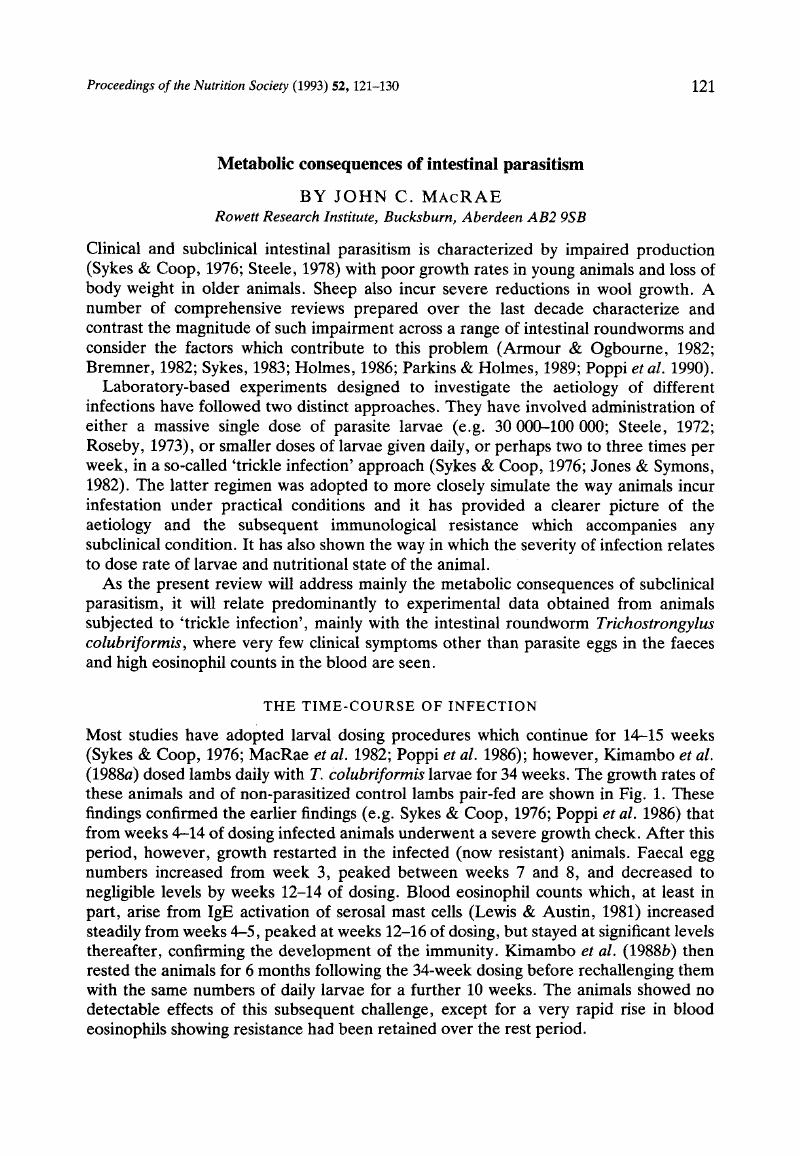Crossref Citations
This article has been cited by the following publications. This list is generated based on data provided by Crossref.
Pathak, A. K.
Dutta, Narayan
Banerjee, P. S.
Pattanaik, A. K.
and
Sharma, K.
1970.
Influence of Dietary Supplementation of Condensed Tannins through Leaf Meal Mixture on Intake, Nutrient Utilization and Performance of Haemonchus contortus Infected Sheep.
Asian-Australasian Journal of Animal Sciences,
Vol. 26,
Issue. 10,
p.
1446.
Suttle, Neville F.
1994.
Seasonal infections and nutritional status.
Proceedings of the Nutrition Society,
Vol. 53,
Issue. 3,
p.
545.
Delahay, R. J.
Speakman, J. R.
and
Moss, R.
1995.
The energetic consequences of parasitism: effects of a developing infection ofTrichostrongylus tenuis(Nematoda) on red grouse (Lagopus lagopus scoticus) energy balance, body weight and condition.
Parasitology,
Vol. 110,
Issue. 4,
p.
473.
MacRae, John C.
Bruce, Les A.
Brown, David S.
and
Calder, A. Graham
1997.
Amino acid use by the gastrointestinal tract of sheep given lucerne forage.
American Journal of Physiology-Gastrointestinal and Liver Physiology,
Vol. 273,
Issue. 6,
p.
G1200.
Tamminga, S.
and
Schrama, J. W.
1998.
Environmental effects on nutrient and energy metabolism in ruminants.
Archiv für Tierernaehrung,
Vol. 51,
Issue. 2-3,
p.
225.
Yu, Feng
Bruce, L.A.
Coop, R.L.
and
MacRae, J.C.
1998.
Leucine metabolism across the gastrointestinal tract of sheep infected with Trichostrongylus colubriformis.
Proceedings of the British Society of Animal Science,
Vol. 1998,
Issue. ,
p.
1.
Yu, Feng
Bruce, L.A.
Coop, R.L.
and
MacRae, J.C.
1998.
Leucine metabolism across the gastrointestinal tract of sheep infected with Trichostrongylus colubriformis.
Proceedings of the British Society of Animal Science,
Vol. 1998,
Issue. ,
p.
1.
Donaldson, J.
van Houtert, M. F. J.
and
Sykes, A. R.
1998.
The effect of nutrition on the periparturient parasite status of mature ewes.
Animal Science,
Vol. 67,
Issue. 3,
p.
523.
Yu, Feng
Bruce, L.A.
Coop, R.L.
Jackson, F
and
MacRae, J.C.
1999.
In vivo leucine oxidation in the gastrointestinal tract of lambs infected with nematode parasite Trichostrongylus colubriformis.
Proceedings of the British Society of Animal Science,
Vol. 1999,
Issue. ,
p.
107.
Knox, M.R
and
Steel, J.W
1999.
The effects of urea supplementation on production and parasitological responses of sheep infected with Haemonchus contortus and Trichostrongylus colubriformis.
Veterinary Parasitology,
Vol. 83,
Issue. 2,
p.
123.
Rehbein, S
Corba, J
Pitt, S.R
Várady, M
and
Langholff, W.K
1999.
Evaluation of the anthelmintic efficacy of an ivermectin controlled-release capsule in lambs under field conditions in Europe.
Small Ruminant Research,
Vol. 33,
Issue. 2,
p.
123.
Coop, R.L.
and
Kyriazakis, I.
1999.
Nutrition–parasite interaction.
Veterinary Parasitology,
Vol. 84,
Issue. 3-4,
p.
187.
Kahn, L.P
Kyriazakis, I
Jackson, F
and
Coop, R.L
2000.
Temporal effects of protein nutrition on the growth and immunity of lambs infected with Trichostrongylus colubriformis.
International Journal for Parasitology,
Vol. 30,
Issue. 2,
p.
193.
Molan, A. L.
McNabb, W. C.
Hoskin, S. O.
and
Barry, T. N.
2000.
Effect of condensed tannins extracted from four forages on the viability of the larvae of deer lungworms and gastrointestinal nematodes.
Veterinary Record,
Vol. 147,
Issue. 2,
p.
44.
Hoskin, S.O
Wilson, P.R
Charleston, W.A.G
and
Barry, T.N
2000.
A model for study of lungworm (Dictyocaulus sp.) and gastrointestinal nematode infection in young red deer (Cervus elaphus).
Veterinary Parasitology,
Vol. 88,
Issue. 3-4,
p.
199.
Mukasa-Mugerwa, E
Lahlou-Kassi, A
Anindo, D
Rege, J.E.O
Tembely, S
Tibbo, Markos
and
Baker, R.L
2000.
Between and within breed variation in lamb survival and the risk factors associated with major causes of mortality in indigenous Horro and Menz sheep in Ethiopia.
Small Ruminant Research,
Vol. 37,
Issue. 1-2,
p.
1.
Houdijk, J.G.M
Kyriazakis, I
Jackson, F
Huntley, J.F
and
Coop, R.L
2000.
Can an increased intake of metabolizable protein affect the periparturient relaxation in immunity against Teladorsagia circumcincta in sheep?.
Veterinary Parasitology,
Vol. 91,
Issue. 1-2,
p.
43.
HOSKIN, S.O
WILSON, P.R
BARRY, T.N
CHARLESTON, W.A.G
and
WAGHORN, G.C
2000.
Effect of forage legumes containing condensed tannins on lungworm (Dictyocaulus sp.) and gastrointestinal parasitism in young red deer (Cervus elaphus).
Research in Veterinary Science,
Vol. 68,
Issue. 3,
p.
223.
Houdijk, J.G. M.
Kyriazakis, I.
Jackson, F.
and
Coop, R. L.
2001.
The relationship between protein nutrition, reproductive effort and breakdown in immunity toTeladorsagia circumcinctain periparturient ewes.
Animal Science,
Vol. 72,
Issue. 3,
p.
595.
Sykes, AR
and
Coop, R L
2001.
Interaction between nutrition and gastrointestinal parasitism in sheep.
New Zealand Veterinary Journal,
Vol. 49,
Issue. 6,
p.
222.



